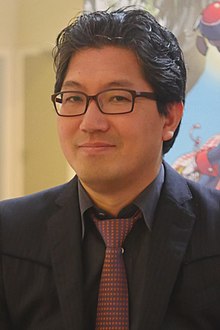Portal:Video games
The Video Games Portal

A video game, also known as a computer game or just a game, is an electronic game that involves interaction with a user interface or input device (such as a joystick, controller, keyboard, or motion sensing device) to generate visual feedback from a display device, most commonly shown in a video format on a television set, computer monitor, flat-panel display or touchscreen on handheld devices, or a virtual reality headset. Most modern video games are audiovisual, with audio complement delivered through speakers or headphones, and sometimes also with other types of sensory feedback (e.g., haptic technology that provides tactile sensations). Some video games also allow microphone and webcam inputs for in-game chatting and livestreaming.
Video games are typically categorized according to their hardware platform, which traditionally includes arcade video games, console games, and computer (PC) games; the latter also encompasses LAN games, online games, and browser games. More recently, the video game industry has expanded onto mobile gaming through mobile devices (such as smartphones and tablet computers), virtual and augmented reality systems, and remote cloud gaming. Video games are also classified into a wide range of genres based on their style of gameplay and target audience. (Full article...)
Featured articles –
The game takes place in Ivalice, where the empires of Archadia and Rozarria are waging an endless war. Dalmasca, a small kingdom, is caught between the warring nations. When Dalmasca is annexed by Archadia, its princess, Ashe, creates a resistance movement. During the struggle, she meets Vaan, a young adventurer who dreams of becoming a sky pirate in command of an airship. They are quickly joined by a band of allies; together, they rally against the tyranny of the Archadian Empire.
Final Fantasy XII was both a critical and commercial success, earning several Game of the Year awards and selling over six million copies on the PlayStation 2 by November 2009. In 2007, a sequel titled Final Fantasy XII: Revenant Wings was released for the Nintendo DS and, in that same year, an expanded version of Final Fantasy XII, titled Final Fantasy XII International Zodiac Job System, was released on the PlayStation 2 exclusively in Japan. A high-definition remaster of the International Zodiac Job System version, The Zodiac Age, was released worldwide for the PlayStation 4 in July 2017, for Windows in February 2018, and for the Nintendo Switch and Xbox One in April 2019. (Full article...)
Nintendo Entertainment Analysis & Development developed the game, led by director Takashi Tezuka and producer and series creator Shigeru Miyamoto. It is the first Mario game for the SNES and was designed to make the most of the console's technical features. The development team had more freedom compared to the series installments for the Nintendo Entertainment System (NES). Yoshi was conceptualised during the development of the NES games but was not used until Super Mario World due to hardware limitations.
Super Mario World is often considered one of the best games in the series and is cited as one of the greatest video games ever made. It sold more than twenty million copies worldwide, making it the best-selling SNES game. It also led to an animated television series of the same name and a 1995 sequel, Yoshi's Island. The game has been re-released on multiple occasions: It was part of the 1994 compilation Super Mario All-Stars + Super Mario World for the SNES and was re-released for the Game Boy Advance as Super Mario World: Super Mario Advance 2 in 2001, on the Virtual Console for the Wii, Wii U, and New Nintendo 3DS consoles, and as part of the Super NES Classic Edition. In 2019, it was released for Nintendo Switch Online as part of the classic games service. (Full article...)
The player assumes the role of a friend of Atrus. A member of the D'ni race, Atrus can create links to other worlds called Ages by writing descriptive books. In Exile, Atrus has written an Age for the D'ni to live on while rebuilding their civilization. The book is stolen by a mysterious figure; the player pursues the thief in an attempt to reclaim Atrus' tablet.
The creators of the Myst franchise gave the task of creating the third Myst game to Presto Studios, known for its adventure game series The Journeyman Project. Presto sought to develop a diverse and logical approach to puzzles and Ages, and worked to make the villain sympathetically multifaceted. The developers hired Jack Wall to develop a musical style different from earlier composer Robyn Miller but still recognizable as a Myst game. The project required millions of U.S. dollars and more than two years to complete. (Full article...)
Ultimate released Knight Lore third in the Sabreman series but later claimed to have completed it first and withheld its release for a year to position the company advantageously in anticipation of the game's effect on the market. Knight Lore's novel image masking technique, Filmation, let images appear to pass atop and behind each other without their contents colliding. This created the illusion of depth priority, which the computer did not natively support. By delaying Knight Lore's release, Ultimate protected sales of their then-upcoming Sabre Wulf and created another Filmation game before other developers could copy the style. Ultimate released the original Sabreman trilogy in quick succession in 1984 for the ZX Spectrum. Knight Lore came last, in November. Ports followed for the BBC Micro, Amstrad CPC, MSX, and Family Computer Disk System.
Knight Lore is regarded as a seminal work in British video game history and has been included in multiple lists of top Spectrum games. Critics considered its technical solutions and isometric 3D style a harbinger of future game design. They praised the game's controls and atmosphere of mystery, but noted its difficult gameplay and criticised its sound and occasional graphical slowdown. Knight Lore was named the 1984 game of the year by the Golden Joystick Awards and Popular Computing Weekly readers. Though it was not the first isometric 3D video game, Knight Lore popularised the format. When the isometric, flip-screen style fell out of fashion, Knight Lore's influence persisted in computer role-playing games. Retrospective reviewers remember the game as the first to offer an exploratory "world" rather than a flat surface, but consider its controls outdated and frustrating in the thirty years since its release. (Full article...)
1080° was announced in November 1997 and developed over nine months. It received critical acclaim and won an Interactive Achievement Award from the Academy of Interactive Arts & Sciences. The game sold over two million units. A sequel, 1080° Avalanche, was released for the GameCube in November 2003. The game was re-released for the Wii in 2008 and for the Wii U Virtual Console in 2016. It was also re-released on the Nintendo Switch Online + Expansion Pack in 2023. (Full article...)
Designer Andrew Shouldice developed Tunic, his first major game, over seven years. He began work on it as a solo project in 2015, wanting to combine challenging gameplay with gentle visual and audio design. He was inspired by his childhood experiences playing Nintendo Entertainment System games like The Legend of Zelda (1986) and trying to understand game manuals for which he lacked context. Shouldice was joined during development by composers Terence Lee and Janice Kwan, audio designer Kevin Regamey, developer Eric Billingsley, and producer Felix Kramer. Publisher Finji joined the project in 2017 and announced Tunic at E3 2017.
Tunic was released for macOS, Windows, Xbox One, and Xbox Series X/S in March 2022, followed by ports for Nintendo Switch, PlayStation 4, and PlayStation 5 in September. It received positive reviews, especially for its aesthetics, design, and gameplay, but drew some criticism for uneven difficulty and potential for players to feel stuck. Tunic won the Outstanding Achievement for an Independent Game award at the 26th Annual D.I.C.E. Awards, and the Artistic Achievement and Debut Game awards at the 19th British Academy Games Awards. (Full article...)
The game follows an elite group of assassins called the "killer7". The assassins, physical manifestations of a man named Harman Smith, perform hits on behalf of the United States government. Through these missions, the killer7 uncover a deeper conspiracy regarding the role of Japan in U.S. politics and secrets about the nature of their organization. Killer7 features first-person shooter elements and a unique on rails control scheme, but the core adventure-style gameplay has been compared to Myst and Snatcher.
Killer7 was Suda's first game released outside Japan. It initially received mixed reviews due to its unconventional control scheme, linear gameplay, and complex noir plot. While some reviewers appreciated the stripped-down controls and stylized arthouse approach, others criticised it as confusing and restricting. However, the game's soundtrack, presentation, visual style and thought-provoking story received generally positive responses from critics, were considered as the best aspects of the game and led to several accolades and nominations. Retrospectively, Killer7 has a cult following, which led to re-releases of Suda's older works and the successful launch of No More Heroes. A Windows port of the game licensed by Capcom was released by NIS America in 2018. (Full article...)
Ocarina of Time was developed by Nintendo's Entertainment Analysis & Development division. It was led by five directors, including Eiji Aonuma and Yoshiaki Koizumi, produced by series co-creator Shigeru Miyamoto, and written by Kensuke Tanabe. Series composer Koji Kondo wrote its soundtrack. The player controls Link in the realm of Hyrule on a quest to stop the evil king Ganondorf by traveling through time and navigating dungeons and an overworld. The game introduced features such as a target-lock system and context-sensitive buttons, which have since become common in 3D adventure games. The player must play songs on an ocarina to progress.
Ocarina of Time was acclaimed by critics and consumers, who praised its visuals, sound, gameplay, soundtrack, and writing. It has been ranked by numerous publications as the greatest video game of all time and is the highest-rated game on the review aggregator Metacritic. It was commercially successful, with more than seven million copies sold worldwide. In the United States, it received more than three times more pre-orders than any other game at the time. A sequel, The Legend of Zelda: Majora's Mask, was released in 2000. Ocarina of Time has been re-released on every one of Nintendo's home consoles and on the iQue Player in China. An enhanced version of the game for the Nintendo 3DS, The Legend of Zelda: Ocarina of Time 3D, was released in 2011. Master Quest, an alternative version of the game including new puzzles and increased difficulty, is included in one of the GameCube releases and the 3D version. (Full article...)
Did you know... -
- ... that Justin Yu, the current Classic Tetris World Champion, is also a cellist in MIT's video game orchestra?
- ... that Goodboy Galaxy was the first commercially released video game for the Game Boy Advance in more than 13 years?
- ... that the case Lewis Galoob Toys, Inc. v. Nintendo of America, Inc. was considered essential to the future of video game modding in the United States in 1992?
- ... that the success of Kingdom Rush prompted plans to grow the video game industry of Uruguay?
- ... that the character Psycho Mantis in the video game Metal Gear Solid breaks the fourth wall by identifying the player's other games?
- ... that a cheat code in the video game Spyro: Year of the Dragon grants access to a near-complete copy of Crash Bash?
- ... that Kainé from the video game series Nier was created in response to a female staff member's vague wish for a "male heroine"?
- ... that the 2005 video game Bokura no Kazoku was inspired in part by the birth of its creator's first child?
- ... that for at least 90 minutes, Mori Calliope livestreamed herself begging video game developer Atlus to allow her to stream their game Persona 3?
- ... that after becoming paralyzed from the neck down, Rocky "RockyNoHands" Stoutenburgh broke two Guinness World Records in the video game Fortnite?
- ... that the web-based video game Moderator Mayhem was based on a card game meant to demonstrate the difficulties of content moderation?
- ... that Elena from the video game series Street Fighter uses a capoeira fighting style, for which the development team used travel videos as reference material as they had no experience with the style?
Selected biography –
Selected image -
Recent video game-related events
- September 12, 2024 – 2023–2024 video game industry layoffs
- Microsoft announces that it will lay off 650 Microsoft Gaming employees as part of cuts to its workforce. (Variety)
- August 15, 2024 –
- American video game magazine Game Informer discontinues publication after 33 years. The magazine's website is also shut down. (BBC News)
- May 24, 2024 – Uvalde school shooting
- Families in Uvalde, Texas, U.S., file a lawsuit against Daniel Defense and Activision Blizzard for creating the DDM4 V7 gun and promoting the weapon through the game Call of Duty, respectively. They also sue Meta Platforms for owning Instagram, which was used by the gunman. (AP)
Topics
Categories
Things you can do
In other Wikimedia projects
The following Wikimedia Foundation sister projects provide more on this subject:
-
Commons
Free media repository -
Wikibooks
Free textbooks and manuals -
Wikidata
Free knowledge base -
Wikinews
Free-content news -
Wikiquote
Collection of quotations -
Wikisource
Free-content library -
Wikiversity
Free learning tools -
Wiktionary
Dictionary and thesaurus














































